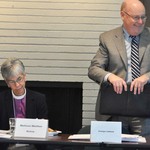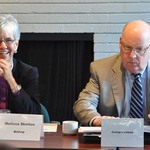1. Welcome & Prayer - Bishop Skelton – 6:30pm
Following the sandwich, fruit and pastry supper served at 6pm, the Bishop opened the meeting with prayer and thanked everyone for being open to the venue change with the move from St. Augustine’s to St John’s, Shaughnessy’s Trendell Lounge.
Bishop Melissa began the meeting by relating some information about her summer involvement in the establishment of a network of diocese’s focusing on the ministry of Congregational Development with leadership and congregational development schools flourishing in various spots around North America . This year saw the completion of the third year of the Diocese of New Westminster’s School for Leadership which the Bishop would like to change to the Diocesan School for Congregational Development.
The Bishop also announced that she is engaged to be married to Eric Stroo a deacon in the Episcopal Diocese of Olympia who is a counselor in the Seattle area. There are no immediate plans but the wedding liturgy will likely be an intimate event in the US Pacific Northwest as both of Eric’s parents are in assisted living situations and living in Oregon. The wedding will be followed by a party here in the Diocese of New Westminster. With a huge smile the Bishop affirmed that after her marriage she will be here in the Diocese of New Westminster.
2. Establishment of Group Norms
The next item on the agenda was the Establishment of Group Norms facilitated by Maureen Simons. This will be the first meeting where the new set of procedures developed over recent years through the White Paper on Diocesan Reorganization have been in practice, therefore the streamlining of the structure from previous Councils will be noticeable. With significant changes now in place, it was determined that a list of the following group norms for consideration by Council would be helpful:
1. On time: start on time and return from breaks on time
2. Respect - everyone is entitled to their opinion and we give each other time without interruptions to state their views
3. Question to clarify - we ask respectful questions to get clarification
4. Offer opinions once - we do not repeat the same information or opinion multiple times
5. No side conversations
6. Preparation - we commit to reviewing materials provided before the meeting and come prepared to discuss items under discussion
7. Allow other suggestions from DC
This list was accepted by Council. In addition there was a brief discussion about finishing “on time” or at a reasonable time given the agendas.
3. Bible Study
Led by the Reverend Janice Lowell, Council took part in a Bible Study using the passage Romans 12: 1-8.
For by the grace given to me I say to everyone among you not to think of yourself more highly than you ought to think, but to think with sober judgement, each according to the measure of faith that God has assigned. For as in one body we have many members, and not all the members have the same function, so we, who are many, are one body in Christ, and individually we are members one of another. We have gifts that differ according to the grace given to us: prophecy, in proportion to faith; ministry, in ministering; the teacher, in teaching; the exhorter, in exhortation; the giver, in generosity; the leader, in diligence; the compassionate, in cheerfulness.
Council was then asked to form small groups for discussion and address the question, “How does this passage from Romans relate to Congregational Development (CD)?” The discussions that followed were enthusiastic. Janice concluded the discussions by resuming her place at the flipchart and easel and asked that each small group provide one piece of feedback connecting the reading to CD. The Chancellor, George Cadman said that in looking at the historical context of Paul’s letters it helps to be aware that this is Paul writing to that very small Christian congregation in Rome, a church in infancy, so this could be viewed as one of the first of many homilies on CD. The respect and recognition of many skills and talents; the discernment of different gifts; the acknowledgement that there is not just one way to build a congregation; that God is dynamic and we can also be dynamic. For many on Council these were the keys of this passage.
4. Congregational Development
Executive Archdeacon, the Venerable Douglas Fenton gave a brief précis introducing the idea that Diocesan Council becomes a place where strategic thinking for the diocese takes place. This is not to take away the focus that there is business to be done but to more deeply engage Council with where things are going over the next few years.
The Bishop facilitated the presentation for this section.
Although many on Council have experienced similar presentations, specifically at Synod 2014, the Bishop wrote the following phrases that apply to CD.
· Primary Task
· Ecclesiastical tradition
· Self-renewing
· Sustainable or working toward sustainability (“fit”)
Bishop Melissa extrapolated each of these phrases and connected them to the larger goal of CD in the parishes of our diocese.
The next person to speak was Council Agenda Committee member Mark Munn, a postulant for ordination and a parishioner at Christ Church Cathedral. Mark distributed the following question the first of three:
Question 1
“Is Congregational Development a priority for our Diocese?”
Instructions (the instructions were the same for each question):
1. Divide into groups of 4 people.
2. Choose a recorder and reporter
3. Write your answer to the question (2 minutes)
4. Let each person read their response without crosstalk (5 minutes)
5. Recorder will write responses.
6. Reporter will share responses with Diocesan Council (8 minutes for all groups) {the length of the responses in the small groups and the response times to the plenary varied somewhat between the three questions}.
Council formed into groups and moved from the large rectangle of tables to different meeting areas.
After 15 minutes of discussion the groups returned to their original places. All the groups heartily endorsed that Congregational Development is a diocesan priority. However, there were some questions raised about how the priority will develop into action and reality:
· Is CD the only priority?
· How will making this priority a reality be resourced?
· There is a need for training. Leaders in parishes need a place to have their development supplemented?
· How does Council reflect in its dealings and decision making the priority of CD?
· Healthy congregations working together will create the environment for a healthy diocese.
Next, Maureen Simons distributed the following question:
Question 2
Diocesan Vision Statement: ‘Growing communities of faith in Jesus Christ to serve God’s mission in the world.’
Marks of Mission
• To proclaim the Good News of the Kingdom
• To teach, baptize, and nurture new believers
• To respond to human need by loving service
• To seek to transform unjust structures of society, to challenge violence of every kind and to pursue peace and reconciliation
• To strive to safeguard the integrity of creation and sustain and renew the life of the earth
The Ten Strategic Priorities in Plan 2018 were found by the implementation group to be reflected in the Marks of Mission.
The Diocesan Vision Statement and Marks of Mission have been our guiding principles. We have just identified a focus– Congregational Development.
“Are these three compatible and how do they support one another?”
Following the small group discussions, the general consensus view was that these three items are compatible, there is equivalency. The themes of the three: Vision Statement; Marks of Mission; Ten Strategic Priorities, by definition encourage us to grow the church. And, they are complimentary. There was general consensus that they are a bit “clunky”, therefore a communications strategy to get the message out could be problematic and will require some work.
Archdeacon Douglas facilitated the third question.Question 3
If Congregational Development, the Diocesan Vision Statement and Marks of Mission are compatible, “what is the work that needs to happen?
If they are not compatible, “what is the work that needs to happen?”
The theme of the small group responses to Question 3 was about commonality. The next work is to educate the diocese using a common language that everyone in parishes will understand in order to facilitate working together and goal determination.
Mark Munn wrapped up this section on CD. All of the answers to the questions and the ideas that were generated by the small group discussions will be looked at by the agenda committee and collated and developed into resolutions for the November 1st meeting.
Prior to the commencement of the Business portion of the Agenda at 8:30pm, Council took a brief break.
There was a minor omission regarding the inclusion of the Chair of Ministry and Mission Development as a member of the Steering Committee. This will be corrected and the Chancellor moved that the Minutes be adopted.
The Minutes were ADOPTED with that correction
7 Items for No Debate
Church of the Good Shepherd – appointment of Trustees
The Chancellor moved that the item be approved and Council approved the MOTION.
8. Items for Debate
Treasurer Bob Hardy spoke to this item. The by-laws that the Artaban board wants to change are specific to the make-up of the board. The suggested motion as appears in the attached document which involves adding a contingent clause to the debt settlement agreement gives some flexibility regarding “sign-off” to changes. This resolution if approved by Council allows the continued ability to work with the board but removes the necessity of having diocesan representation on the Artaban board.
The Chancellor affirmed that this is a natural progression based on recent decsions made about the relationship of the two organizations. This is a severing of the support relationship that has existed between the diocesan and the Artaban board.
The MOTION was passed
Council moved In Camera at 8:50pm and moved Ex Camera at 9:47pm
9 Nominations
Bob Hardy spoke to the nomination of the Venerable John Stephens to the Management, Finance and Property Committee.The Venerable Stephen Rowe, Archdeacon of Fraser had recently resigned from the committee.
The Nomination was APPROVED.
10 Items for Information
Correspondence: Letter from the Primate 7-2-2014
Letter from Richard Topping 6-3-2014
Letter from Richard Topping 8-27-2014
Letter from Peggy Trendell-Jensen 6-22-2014
The Bishop advised Council to look over the items for information and Rob Dickson added that if anyone had any questions about the Financial Statements that they should contact him or the Diocesan controller Mark Beley.
Prior to adjournment the Bishop conducted a quick meeting assessment asking Council to respond on a scale of 1-5 about their general feelings about the meeting. The majority of Council were in the high positive area.
The Reverend Father Louie Engnan closed with a prayer and Bishop Melissa Skelton adjourned Council at 10pm.
The next meeting of Diocesan Council is scheduled for All Saints’ Day, Saturday, November 1st, 2014, 9:30am (gathering at 9am)-4pm at the Trendell Lounge at St. John’s, Shaughnessy.
Images:
1. Two conversations, the Reverend Louie Engnan and the Venerable Lynne McNaughton and behind at the staff table, the Reverend Ruth Monette and Rob Dickson.
2.The Reverend Dale Yardy, the Reverend Trudy Shaw and Maureen Simon enjoy the meal together.
4. Val Casselton, the Reverend David Price and Cameron Gutjahr during the Bible Study discuss
5. The Bishop engages Council with some CD
6. Everyone has left to meet in their small groups
7. A small group discussion working on the question, “If Congregational Development, the Diocesan Vision Statement and Marks of Mission are compatible, ‘what is the work that needs to happen?’”
8. Kim Blair and Ian Thomas reporting back
9. The Bishop and the Chancellor as the business portion of the meeting gets underway.
10. Evaluating the meeting on a 1-5 scale



















